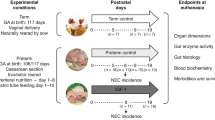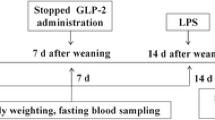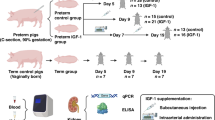Summary
Conclusion
EGF and/or transforming growth factor-α (TGF-α) are likely to be important in the rapid pancreatic growth that occurs in the neonatal guinea pig.
Background
Rapid pancreatic growth is observed during the neonatal period in the guinea pig. The growth factors that are involved are not known but may include members of the EGF family.
Methods
Mini-osmotic pumps were implanted on the day of birth for continuous infusion of EGF (30 μg/d). Pancreatic DNA, RNA, and protein contents were determined at 4 and 15 d, along with wet weights of the pancreas, duodenum, jejunoileum, colon, and gallbladder. Pancreatic EGF and TGF-α concentrations were measured in adult controls, in control neonates at 1, 4, 8, and 15 d, and also at d 4 and 15 in guinea pigs receiving either EGF or the cholecystokinin receptor antagonist devazepide (25 nmol/kg/h).
Results
EGF infusion significantly increased the weight of the stomach and duodenum at 4 d and all the gastrointestinal organs, including the pancreas, at 15 d. Exogenous EGF increased pancreatic DNA, RNA, and protein content at 4 and 15 d. Endogenous EGF and TGF-α concentrations in the pancreas were significantly higher at birth than in adults (P<0.001 andP<0.01, respectively) and declined during the first 2 wk postpartum. At 15 d, EGF concentrations remained significantly higher than adult levels (P<0.01), but TGF-α concentrations had declined to adult values. Infusion of EGF decreased concentrations of endogenous EGF in the pancreas at 4 and 15 d (bothP<0.05) and decreased TGF-α concentrations at 4 d (P<0.001). Devazepide infusion caused a significant decrease in endogenous pancreatic EGF concentrations at 15 d (P<0.05).
Similar content being viewed by others
References
Cohen S. Isolation of a mouse submaxillary gland protein accelerating incisor eruption and eyelid opening in the newborn animal.J Clin Gastroenterol 1962;13 (Suppl 1):S88-S97.
Carpenter G, Cohen S. Epidermal growth factor.J Biol Chem 1990;265:7709–7712.
Berseth CL. Enhancement of intestinal growth in neonatal rats by epidermal growth factor in milk.Am J Physiol 1987;253:G662-G665.
Falconer J. Oral epidermal growth factor is trophic for the stomach in the neonatal rat.Biol Neonate 1987;52:347–350.
Feldman EJ, Aures D, Grossman M. Epidermal growth factor stimulates ornithine decarboxylase activity in the digestive tract of mouse.Proc Soc Exp Biol Med 1978; 159:400–402.
Malo D, Menard D. Influence of epidermal growth factor on the development of suckling mouse intestinal mucosa.Gastroenterology 1982;83:28–35.
O’Loughlin EV, Chung M, Hollenberg M, Hayden J, Zahavi I, Gall DG. Effect of epidermal growth factor on ontogeny of the gastrointestinal tract.Am J Physiol 1985;249:G674-G678.
Fisher DA, Lakshmanan J. Metabolism and effects of epidermal growth factor and related growth factors in mammals.Endocrine Rev 1990;11:418–442.
Konturek PC, Konturek SJ, Brzozowski T, Ernst H. Epidermal growth factor and transforming growth factor-alpha: role in protection and healing of gastric mucosal lesions.Eur J Gastroenterol Hepatol 1995; 7:933–937.
Ibbotson KJ, Harrod J, Gowen M, D’Souza S, Winkler ME, Derynck R, Mundy GR. Human recombinant transforming growth factor a stimulates bone resorption and inhibits formation in vitro.Proc Natl Acad Sci USA 1986;83:2228–2232.
Twardzik DH. Differential expression of transforming growth factor-a during prenatal development of the mouse.Cancer Res 1985;45:5413–5416.
Joekel CS, Herrington MK, Vanderhoof JA, Adrian TE. Postnatal development of circulating cholecystokinin and secretin, pancreatic growth, and exocrine function in guinea pigs.Int J Pancreatol 1993;13:1–13.
Chang RSL, Lotti VJ. Biochemical and pharmacological characterization of an extremely potent and selective non-peptide cholecystokinin antagonist.Proc Natl Acad Sci USA 1986;83:4923–4926.
Williams JA, Hallden G, McChesney D, Szecowka J, Logsdon CD, Goldfine JD. The cholecystokinin and gastrin receptors, inNeuropeptides and Their Receptors, Schwartz TW, Hilsted LM, Rehfeld JF, eds. Munksgaard, Copenhagen (Alfred Bernzon Symposium no. 29) 1990; pp. 310–319.
Moran TH, Robinson PH, Goldrich MS, McHugh PR. Two brain cholecystokinin receptors: implications for behavioral actions.Brain Res 1986;362:175–179.
Zucker KA, Adrian TE, Bilchik AJ, Modlin IM. Effects of the CCK receptor antagonist L364,718 on pancreatic growth in adult and developing animals.Am J Physiol 1989;257:G511-G516.
Herrington MK, Joekel CS, Vanderhoof JA, Adrian TE. On the importance of cholecystokinin in neonatal pancreatic growth and secretory development in guinea pigs.Pancreas 1995;11:38–46.
Burton K. A study of the conditions and mechanism of the diphenylamine reaction for the colorimetric estimation of deoxyribonucleic acid.Biochem J 1956;62:315–323.
Giles KW, Myers A. An improved diphenylamine method for the estimation of deoxyribonucleic acid.Nature 1965;206:93–95.
Ceriotti G. Determination of nucleic acids in animal tissues.J Biol Chem 1955;214:59–65.
Bradford MM. A rapid and sensitive method for the quantitation of microgram quantities of protein utilizing the principal of protein-dye binding.Anal Biochem 1976;72:248–254.
Ceska M, Birath K, Brown B. A new and rapid method for the clinical determination of amylase activities in human serum and urine.Clin Chim Acta 1969;26:437–444.
Skullman S, Adrian TE, Permert J, Larsson J. Humoral growth factors in plasma and liver tissue during liver regeneration and malnutrition.Eur J Gastroenterol Hepatol 1994;6:797–802.
Gregory H, Holmes JE, Willshire IR. Urogastrone—epidermal growth factor, inMethods of Hormone Radioimmunoassay, Jaffe BM, Behrman HR, eds. Academic, New York, 1979; pp. 927–939.
Puccio F, Lehy T. Oral administration of epidermal growth factor in suckling rats stimulates cell DNA synthesis in fundic and antral gastric mucosae as well as in intestinal mucosa and pancreas.Regul Pept 1988;20:53–64.
Playford RJ, Boulton R, Ghatei MA, Bloom SR, Wright NA, Goodlad RA. Comparison of the effects of transforming growth factor and epidermal growth factor on gastrointestinal proliferation and hormone release.Digestion 1996;57:362–367.
Lajas AI, Pozo MJ, Salido GM, Singh J, Pariente JA. Secretory activity and trophic effects of epidermal growth factor in the rat pancreas.Arch Physiol Biochem 1996; 104:293–299.
Poulsen SS, Kryger-Baggesen N, Nexo E. Immunohistochemical localization of epidermal growth factor in the second-trimester human fetus.Histochem Cell Biol 1996;105:111–117.
Hormi K, Lehy T. Development expression of transforming growth factor-alpha and epidermal growth factor receptor proteins in the human pancreas and digestive tract.Cell Tissue Res 1994;278:439–450.
Tomioka T, Toshkov I, Kazakoff K, Andren-Sandberg A, Takahashi T, Buchler M, Friess H, Vaughn R, Pour PM. Cellular and subcellular localization of transforming growth factor-alpha and epidermal growth factor receptor in normal and diseased human and hamster pancreas.Teratog Carcinog Mutagen 1995;15:231–250.
Visser CJ, Woutersen RA, Bruggink AH, van Garderen-Hoetmer A, Seifert-Bock I, Tilanus MG, de Weger RA. Transforming growth factor-alpha and epidermal growth factor expression in the exocrine pancreas of azaserine-treated rats: modulation by cholecystokinin or a low fat, high fiber (caloric restricted) diet.Carcinogenesis 1995; 16:2075–2082.
Visser CJ, Bruggink AH, Korc M, Kobrin MS, de-Weger RA, Seifert-Bock I, Van Blokland WT, Van Garderen-Hoetmer A, Woutersen RA. Overexpression of transforming growth factor-alpha and epidermal growth factor receptor, but not epidermal growth factor, in exocrine pancreatic tumours in hamsters.Carcinogenesis 1996; 17:779–785.
Author information
Authors and Affiliations
Rights and permissions
About this article
Cite this article
Herrington, M.K., Joekel, C.S. & Adrian, T.E. Effects of epidermal growth factor on neonatal pancreatic growth in the guinea pig. Int J Pancreatol 24, 35–41 (1998). https://doi.org/10.1007/BF02787529
Received:
Revised:
Accepted:
Issue Date:
DOI: https://doi.org/10.1007/BF02787529




